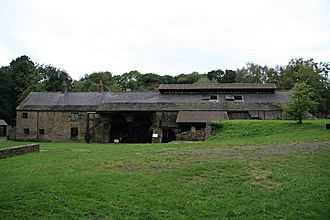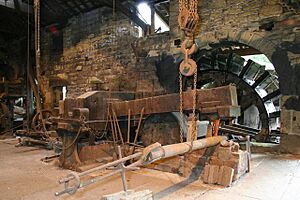Wortley Top Forge facts for kids
Quick facts for kids Wortley Top Forge |
|
|---|---|

Wortley Top Forge
|
|
| General information | |
| Location | Wortley, South Yorkshire |
| Country | England |
| Coordinates | 53°29′41″N 1°33′29″W / 53.494669°N 1.557946°W |
| Designated: | 30 July 1952 |
| Reference #: | 1018262 |
|
Listed Building – Grade I
|
|
| Designated: | 18 March 1968 |
| Reference #: | 1018262 |
Wortley Top Forge is a very old and important place in South Yorkshire, England. It's a former ironworks where people used to make things out of iron. The forge is located near the village of Wortley, right by the River Don.
This historic site first started making iron in the 1600s. Some clues even suggest that iron was worked in this area as early as the 1300s! It's a fascinating look into how things were made long ago.
Contents
A Look Back at the Forge's History
Wortley Top Forge was always connected to another nearby forge called Wortley Low Forge. Both forges likely started around 1639 or 1641. Early owners included Thomas Cotton and his son, William Cotton.
During the English Civil War (which happened in the 1640s), it's believed that cannonballs were made right here at Wortley Top Forge! Imagine huge hammers shaping metal for cannons.
After the war, the forges were often rented by important iron-making families, like the Spencer family. For a long time, the two forges were rented along with a blast furnace (a special oven for melting iron ore) called Nether Bank Furnace. That furnace closed around 1780.
New Owners and New Ideas
In 1744, a man named John Cockshutt took over the forge with a partner. He also had a 'tinmill' nearby, which made tinplate (thin sheets of iron coated with tin).
Later, around 1800, James Cockshutt, John's brother, took charge. James had worked at a big ironworks in Wales. When he came back to Wortley, he brought new ideas. He introduced a process called "puddling," which helped make stronger, purer iron. The tinmill was probably changed to help roll the iron into bars.
After James passed away in 1820, the forge changed hands a few times. In 1849, Thomas Andrews became the owner. When he died in 1871, his son, also named Thomas Andrews, took over.
Making Railway Parts and Scientific Discoveries
One of the buildings at Top Forge has a stone with the date 1713 carved into it. However, the way the forge looks today mostly comes from the 1850s. Around that time, the forge started making parts for railway wagons, especially strong shafts and axles.
The second Thomas Andrews was not just an owner; he was also a famous engineer and metallurgist (someone who studies metals). He did some of the world's earliest experiments with metals right here at Wortley Top Forge! The railway axles made here in the 1800s were known for their high quality and were sent all over the world.
From Working Forge to Museum
Production at Wortley Top Forge stopped around 1912, but some parts of the site were still used until 1929. In the early 1930s, one of the huge hammers was even run for a demonstration.
In 1955, a dream came true! C. R. Andrews (the son of the second Thomas Andrews) wanted the forge to be preserved. It was reopened as an industrial museum by the Sheffield Trades Historical Society (now called the South Yorkshire Industrial History Society).
From the mid-1960s, a dedicated volunteer named Ken Hawley was the Honorary Curator for over 40 years. He led a team of volunteers who worked hard to save and restore the forge to its amazing condition today. Their efforts were recognized when Ken Hawley was awarded an MBE in 1998.
Water Power and Old Machines
One of the most interesting things about Wortley Top Forge is that it always used waterwheels to power its machinery. All three of the waterwheels have been fixed up and can work again!
The buildings at the forge now hold many different old industrial machines. You can even see a Marshall twin-cylinder steam engine there. It's a great place to see how people used to make things before electricity was common.
Protecting Our Heritage
Wortley Top Forge is a very important historical site. The entire area is a "Scheduled Monument," which means it's protected by law because of its historical value. The main forge building is also a "Grade I listed building," which is the highest level of protection for historic buildings in England. Other cottages nearby are also listed as Grade II buildings.
See also
- Grade I listed buildings in South Yorkshire
- Listed buildings in Hunshelf


